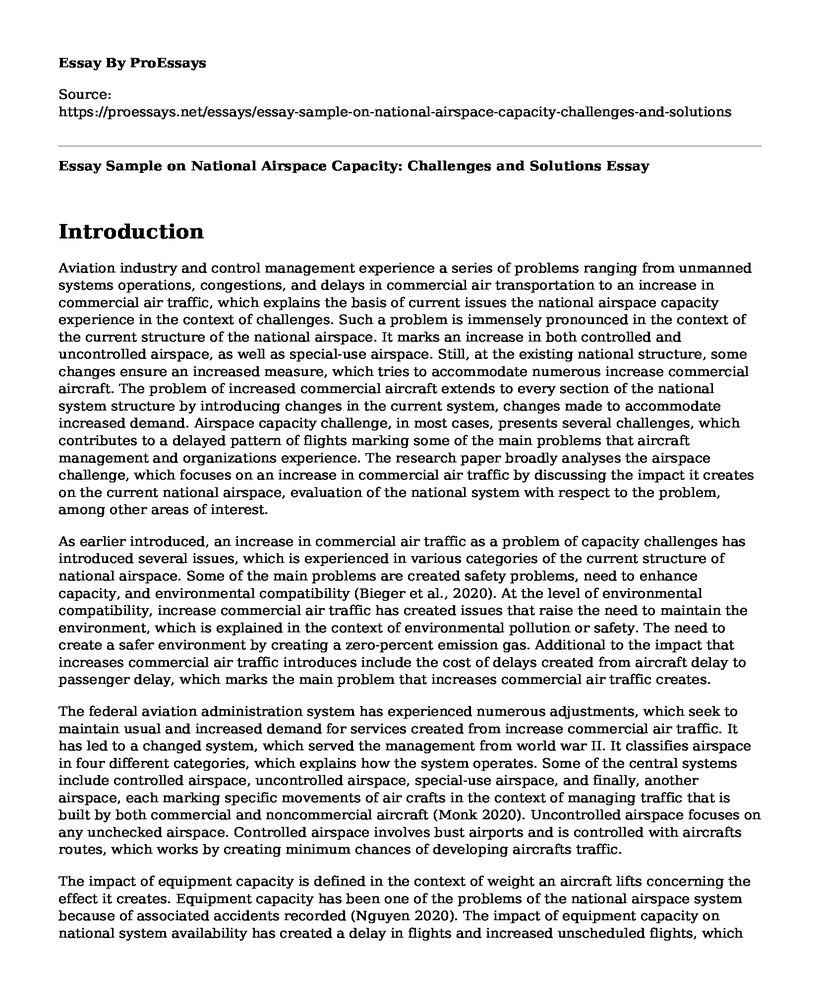Introduction
Aviation industry and control management experience a series of problems ranging from unmanned systems operations, congestions, and delays in commercial air transportation to an increase in commercial air traffic, which explains the basis of current issues the national airspace capacity experience in the context of challenges. Such a problem is immensely pronounced in the context of the current structure of the national airspace. It marks an increase in both controlled and uncontrolled airspace, as well as special-use airspace. Still, at the existing national structure, some changes ensure an increased measure, which tries to accommodate numerous increase commercial aircraft. The problem of increased commercial aircraft extends to every section of the national system structure by introducing changes in the current system, changes made to accommodate increased demand. Airspace capacity challenge, in most cases, presents several challenges, which contributes to a delayed pattern of flights marking some of the main problems that aircraft management and organizations experience. The research paper broadly analyses the airspace challenge, which focuses on an increase in commercial air traffic by discussing the impact it creates on the current national airspace, evaluation of the national system with respect to the problem, among other areas of interest.
As earlier introduced, an increase in commercial air traffic as a problem of capacity challenges has introduced several issues, which is experienced in various categories of the current structure of national airspace. Some of the main problems are created safety problems, need to enhance capacity, and environmental compatibility (Bieger et al., 2020). At the level of environmental compatibility, increase commercial air traffic has created issues that raise the need to maintain the environment, which is explained in the context of environmental pollution or safety. The need to create a safer environment by creating a zero-percent emission gas. Additional to the impact that increases commercial air traffic introduces include the cost of delays created from aircraft delay to passenger delay, which marks the main problem that increases commercial air traffic creates.
The federal aviation administration system has experienced numerous adjustments, which seek to maintain usual and increased demand for services created from increase commercial air traffic. It has led to a changed system, which served the management from world war II. It classifies airspace in four different categories, which explains how the system operates. Some of the central systems include controlled airspace, uncontrolled airspace, special-use airspace, and finally, another airspace, each marking specific movements of air crafts in the context of managing traffic that is built by both commercial and noncommercial aircraft (Monk 2020). Uncontrolled airspace focuses on any unchecked airspace. Controlled airspace involves bust airports and is controlled with aircrafts routes, which works by creating minimum chances of developing aircrafts traffic.
The impact of equipment capacity is defined in the context of weight an aircraft lifts concerning the effect it creates. Equipment capacity has been one of the problems of the national airspace system because of associated accidents recorded (Nguyen 2020). The impact of equipment capacity on national system availability has created a delay in flights and increased unscheduled flights, which explains the basis of equipment capacity as connected to its impact.
A proposed recommendation to increase the capacity of the national airspace falls under the categories of airspace. There should be expanded categories to combat unscheduled aircraft to reduce impacts such as move creates-an increase in current six flight services stations due to increased demand as commercial flights air traffic increase.
Conclusion
To sum up, airspace space capacity challenges range from unmanned systems to an increase in commercial air traffic challenges, among other issues. The national airspace system introduces various categories of airspaces AR traffic control centers, and technological changes, among other plans. The change plan seeks to elevate aircraft service.
References
Bieger, D., Carr, J., Eckert, M. T., Smith, B. A., Struckmann, K., & Waranauskas, B. (2020, January). Impact-Based Decision Support Services for the National Airspace System: A Case Study of Two High-Impact Thunderstorm Events on Traffic Flow Management. In the 100th American Meteorological Society Annual Meeting. AMS. https://ams.confex.com/ams/2020Annual/webprogram/Session52573.html
Monk, K. J. (2020). Unmanned Aircraft Systems (UAS) Integration in the National Airspace System (NAS) Project: Low SWaP HITL 2, SC-228 Outbrief, EO/IR & ATAR Breakout. https://ntrs.nasa.gov/archive/nasa/casi.ntrs.nasa.gov/20200000659.pdf
Nguyen, T. V. (2020). Exploring Dynamic Delegated Corridors and 4D Required Navigation Performance Trajectory to Enable UAM Aircraft to Integrate into the Existing Airspace System. https://commons.erau.edu/ntas/2020/presentations/34/
Cite this page
Essay Sample on National Airspace Capacity: Challenges and Solutions. (2023, May 07). Retrieved from https://proessays.net/essays/essay-sample-on-national-airspace-capacity-challenges-and-solutions
If you are the original author of this essay and no longer wish to have it published on the ProEssays website, please click below to request its removal:
- Ryanair's Development of an Airline Business Essay
- The Federal Aviation Act of 1958 Essay
- Airplane Is the Safety Mode of Transport - Essay Sample
- Essay Sample on US Air Transport Industry: Critical Element in Economy
- Emirates Airlines CMO Rashed Al Nuamini: Setting Objectives, Co-working With Teams - Essay Sample
- Bicultural Partnership: Air NZ & Ngati Porou's Impact on Business Activities - Essay Sample
- A Dream to Fly: My Journey to Becoming a Pilot - Essay Sample







